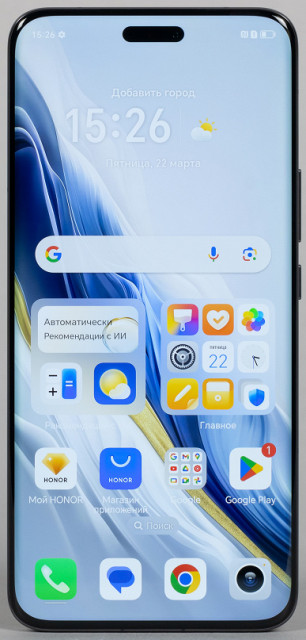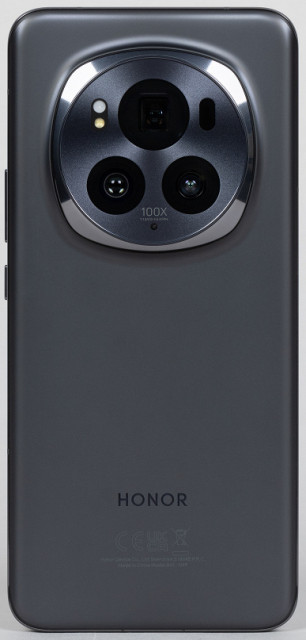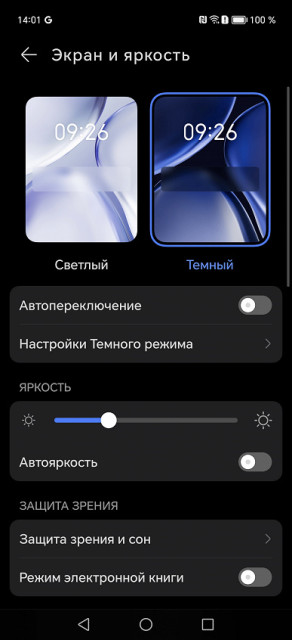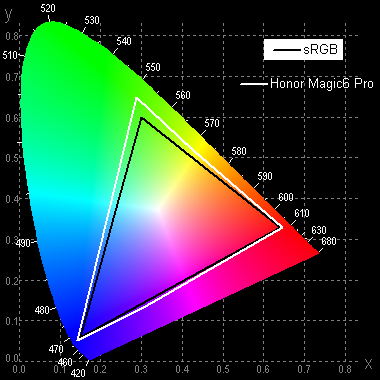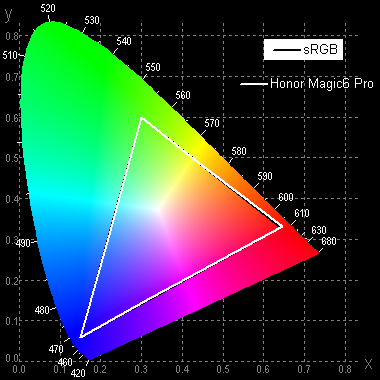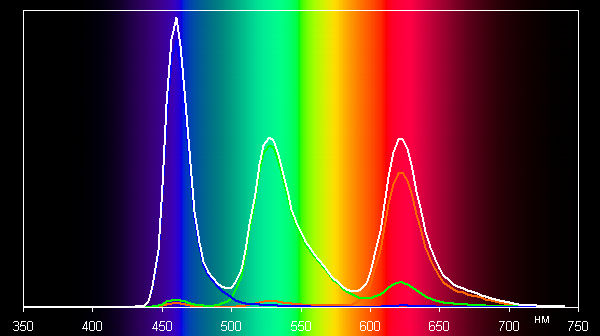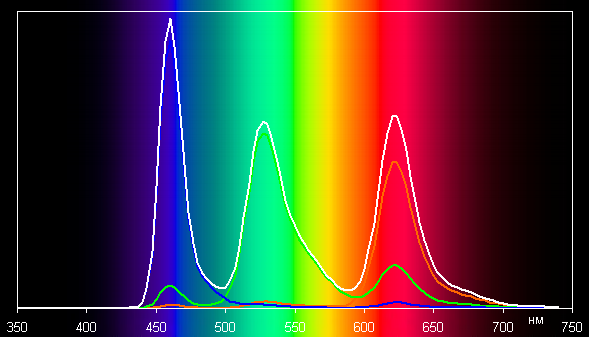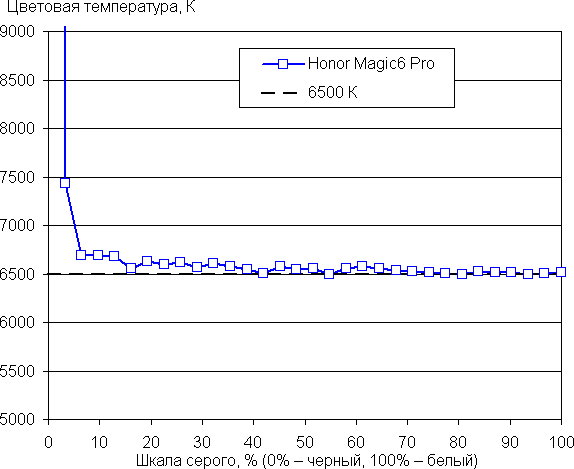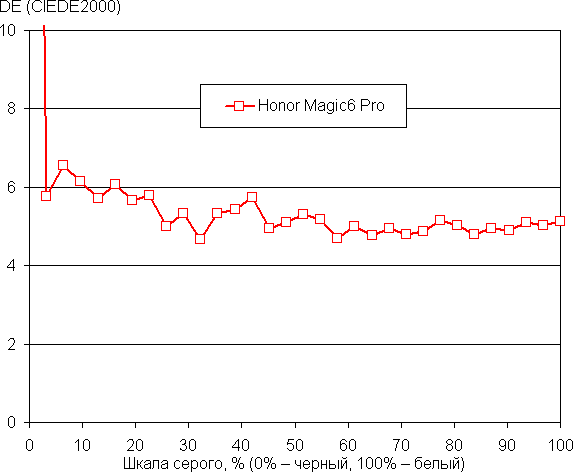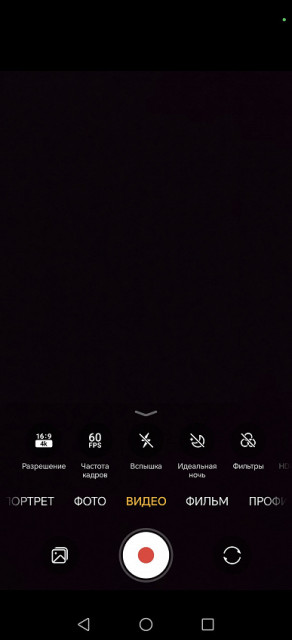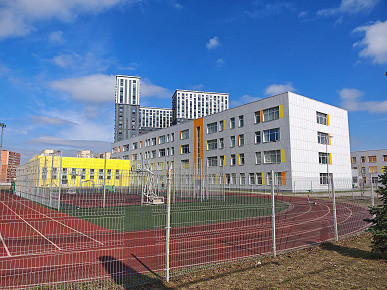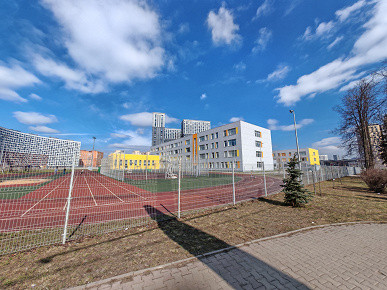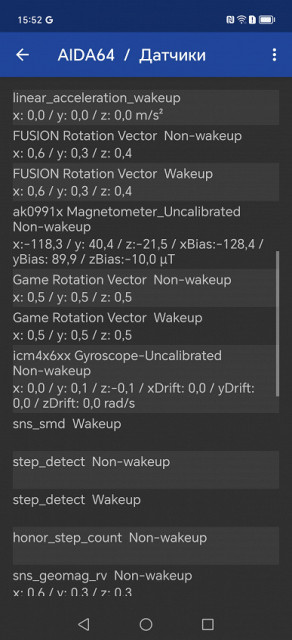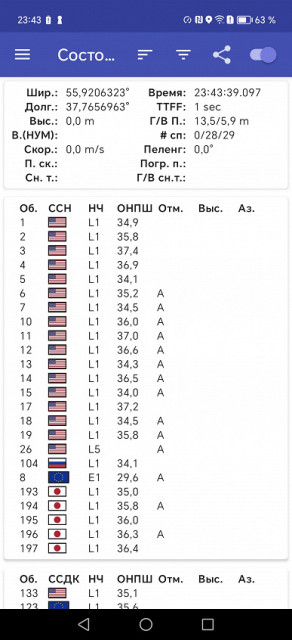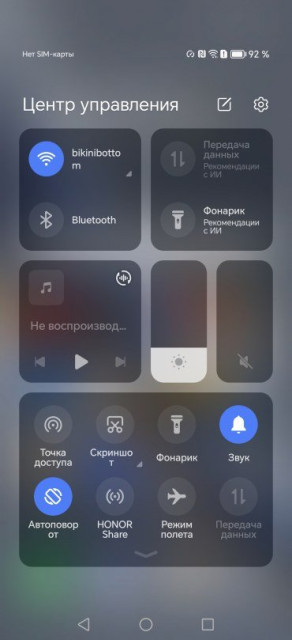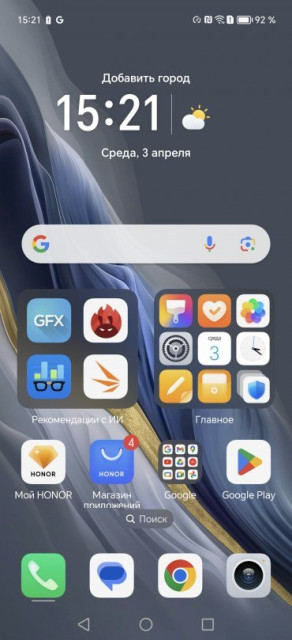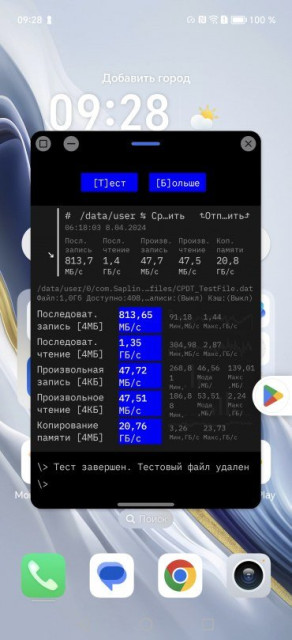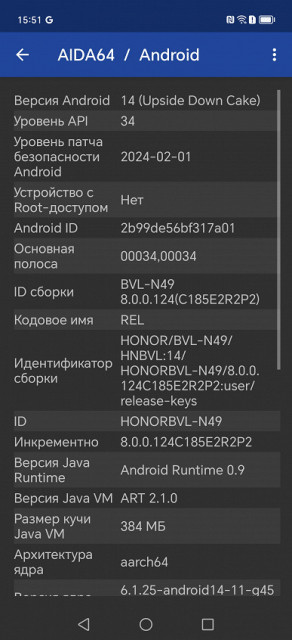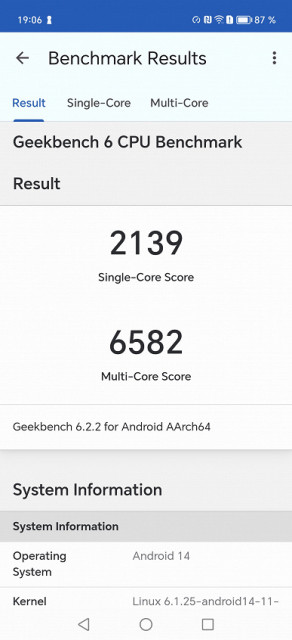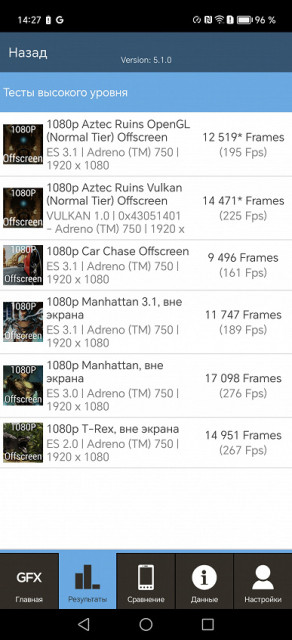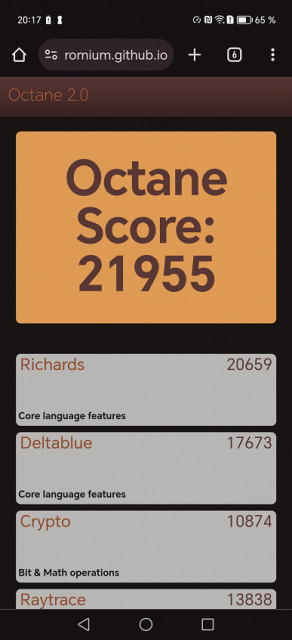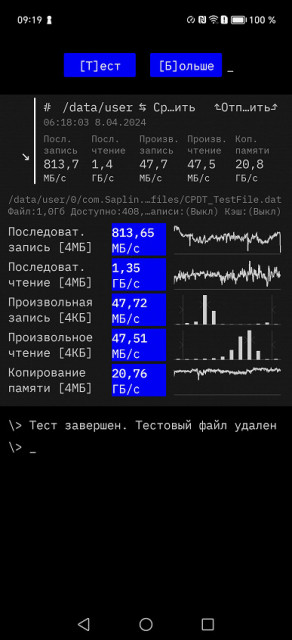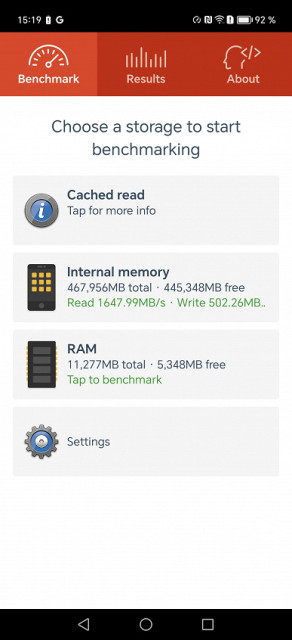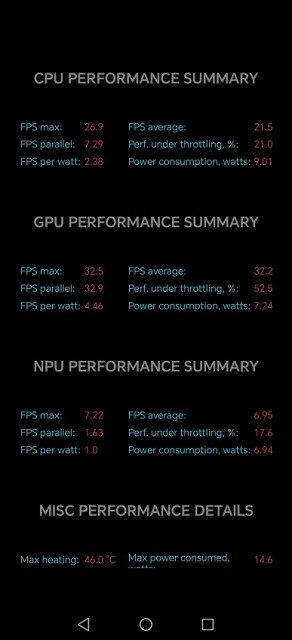This is the brand's flagship device, occupying the top of the product line. It features a chic design, premium materials, powerful cameras, impressive stereo sound and many other interesting features. A full review of this outstanding mobile device is coming.

Main characteristics of Honor Magic6 Pro
- SoC Qualcomm Snapdragon 8 Gen3, 8 processor cores (1×Cortex-X4 @3.3 GHz + 3×Cortex-A720 @3.2 GHz + 2×Cortex-A720 @3.0 GHz + 2×Cortex-A520 @2 .3 GHz)
- GPU Adreno 750
- Operating system Android 14, MagicOS 8
- Touch display Super AMOLED, 6.8″, 1280×2800, 19.5:9, 453 ppi, 120 Hz
- RAM 12 GB (LPDDR5X), internal memory 512 GB (UFS 4.0)
- No microSD support
- Nano-SIM support (2 pcs.)
- Networks 2G GSM, 3G WCDMA, 4G LTE, 5G
- GPS (L1+L5), Glonass, BDS (B1I+B1c+B2a), Galileo (E1+E5a)
- WiFi 7
- Bluetooth 5.3, A2DP, LE, aptX HD
- NFC
- USB 3.2 Type-C, DisplayPort 1.2, USB OTG
- There is no 3.5mm audio output for headphones
- Rear cameras 50 MP + 180 MP (telephoto) + 50 MP (wide-angle), video 4K@60 fps, gyro-EIS, HDR, 10 bit
- Front camera 50 MP
- Proximity and lighting sensors, magnetic field, accelerometer, gyroscope
- Fingerprint scanner (under-screen, optical)
- Stereo speakers
- Protection degree IP68
- 5600 mAh battery, 80 W charging (PD 3.0), 66 W wireless charging
- Dimensions 163×76×8.9 mm
- Weight 225 or 229 g
Appearance and ease of use
The Honor Magic6 Pro smartphone comes in a large cardboard box with a minimalist design.
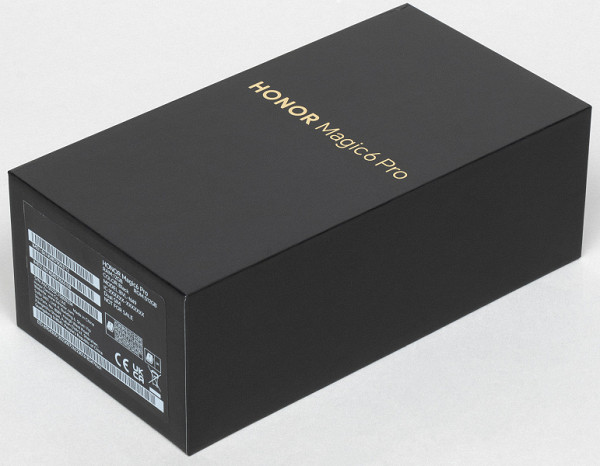
The kit includes a charger (100 W) and an interface cable. There is no cover included.
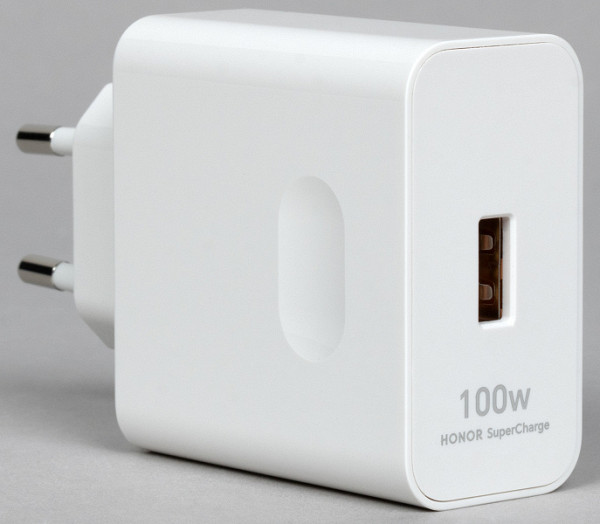
The Honor Magic6 Pro smartphone is a large and massive device that feels heavy in the hand. This is due to protruding cameras, increased battery capacity and a larger screen. The design of the device is made in a classic flagship style with curved edges on both the front and back.
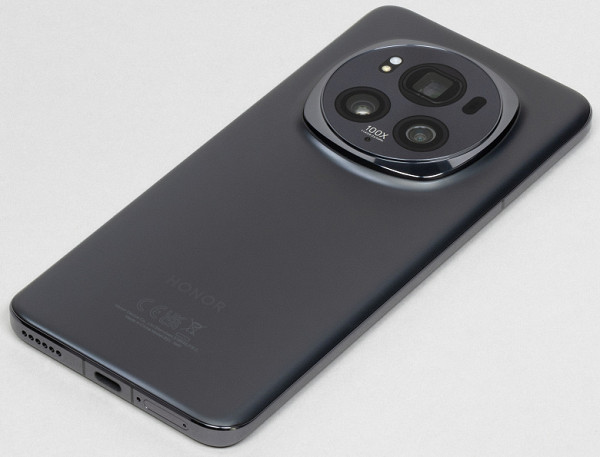
Two panels of tempered glass are used, but options with an eco-leather back panel are also available. The screen, unfortunately, is not flat, but has curved, shiny and slippery edges. NanoCrystal Shield glass is used, developed in our own laboratory, which is highly durable.

The side frame is massive, durable and made of real metal. It gives the whole design a feeling of reliability, but at the same time the smartphone has become less comfortable to hold in the hand — the smooth and rounded sides slide easily in the palm.

On the back of the body you can see a massive camera block, made in an intricate shape, with several lenses and flashes. The corners of the case are generously rounded, which forced the corners of the screen to be strongly rounded.
Thanks to the massive camera block, which occupies almost the entire width of the body and protrudes, the device lies stably on any flat surface and does not wobble when using the screen.

The buttons are conveniently located on one side, right under your finger. The keys are large, protruding well, and have a clear response.

The fingerprint scanner is placed under the glass of the screen very close to the bottom edge, which can be inconvenient when using one hand. However, the optical sensor works as standard: you need to hold your finger a little, but there are no false alarms.

There is only one front camera, but next to it there is a TOF 3D sensor, which is why the cutout in the screen is elongated. The 3D sensor improves the reliability of facial recognition, allowing it to be used for authentication in banking applications. In addition, unlocking works even in conditions of practical darkness.
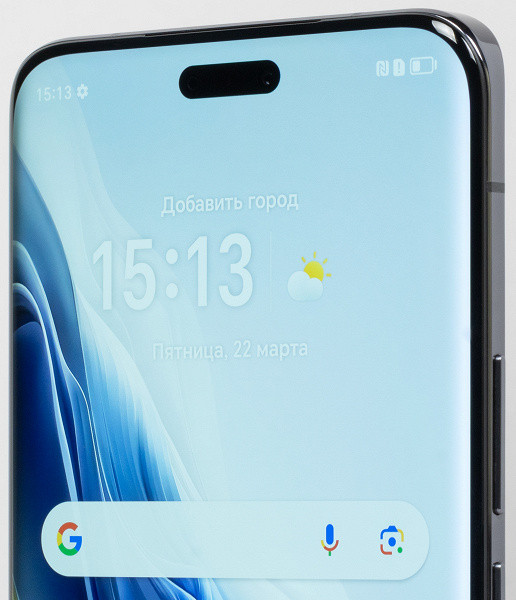
The slide-out tray can accommodate two Nano-SIM cards. There is no room for a microSD memory card.
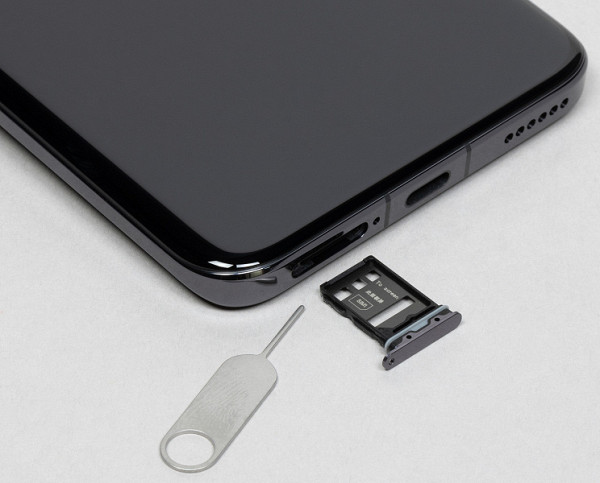
At the bottom there is a speaker, a microphone and a USB Type-C connector. There is no 3.5 mm audio output for the minijack of wired headphones.

An additional microphone and speaker are installed at the top end.

Honor Magic6 Pro is protected against dust and water according to the IP68 standard, which allows you to immerse it in fresh water to a depth of 1.5 meters for half an hour. The global version of the smartphone is available in two color options for the case, with a rear panel made of frosted glass or eco-leather, depending on the user’s choice.
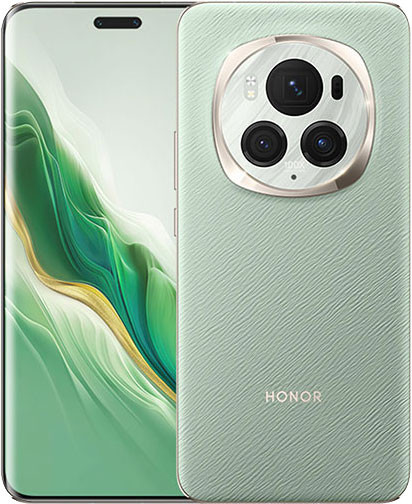
Screen
The Honor Magic6 Pro smartphone is equipped with a 6.8-inch AMOLED display with a resolution of 1280×2800 (19.5:9) and protective glass (Honor NanoCrystal Shield) with curved edges. The matrix size is 72x157 mm, and the dot density reaches 453 ppi. The width of the frame around the screen is about 2 mm at the top and sides, and about 3 mm at the bottom. This display supports a 120Hz refresh rate, HDR mode, and multi-touch up to 10 touches.
The front panel of the screen is made of glass with a mirror-like smooth surface that is scratch-resistant. The anti-glare properties of the screen are superior to those of the Nexus 7 screen. A special oleophobic coating on the outer surface makes fingerprints easily removed. The maximum screen brightness when displaying a white field under normal conditions reaches 730 cd/m² and can increase to 1200 cd/m² in bright light (up to 1500 cd/m² in HDR mode). The screen provides good readability during the day in the sun thanks to its excellent anti-glare properties. The minimum brightness value is 2 cd/m², which allows you to use the device even in complete darkness. Automatic brightness adjustment is carried out using a light sensor, allowing the user to adjust the brightness to individual requirements.
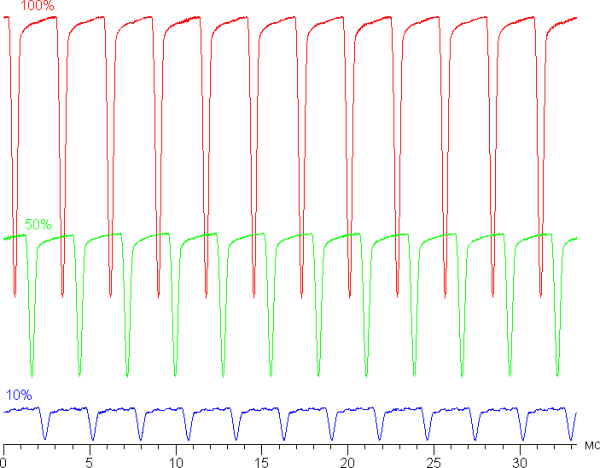
Visually, flickering is not observed at any brightness level due to the small duty cycle of the modulation and the different phase of modulation over the screen area. However, when the brightness is greatly reduced, below approximately 15 cd/m², the modulation becomes noticeable in the stroboscopic effect test.
The manufacturer claims that PWM is used with a frequency of 4320 Hz. By measuring at 10% brightness in a narrow area of the screen, we were able to detect modulation at exactly this frequency.
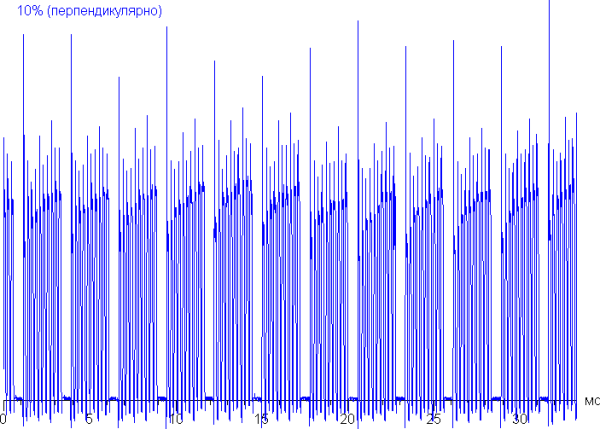
This is due to the fact that in standard measurements the sensor covers an area with a diameter of about 8 mm, which covers several zones with different modulation phases. Because of this, high frequency modulation may go unnoticed. However, low frequency modulation is still present, confirming the above.
In the screen settings, you can activate a mode with an increased refresh rate of up to 120 Hz.

The nature of the modulation remains unchanged. It is important to note that on static and slow-moving images, the refresh rate is always reduced to 30 Hz.
This screen uses an AMOLED matrix, which is an active matrix organic light-emitting diode. A full-color image is formed using subpixels of three colors: red ®, green (G) and blue (B). However, the number of red and blue subpixels is half that, which is referred to as RGBG. This is confirmed by a fragment of a microphotograph.
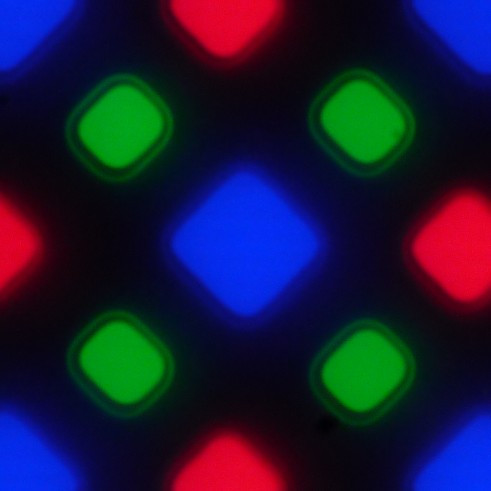
In the fragment above you can see 4 green subpixels, 2 red (4 halves) and 2 blue (1 whole and 4 quarters). By repeating these fragments, you can fill the entire screen without gaps or overlaps. For such matrices, Samsung uses the term PenTile RGBG. The manufacturer calculates screen resolution based on green subpixels, so it is lower for the other two. Contrary to these features, artifacts such as jagged contrast borders have minimal impact on image quality due to the high resolution.
The screen has excellent viewing angles. The brightness at an angle for both screens decreases slightly (compared to the Nexus 7), but the drop in brightness for the smartphone is significantly less. As a result, at the same brightness, the smartphone screen appears visually brighter (compared to LCD screens), especially in angular viewing. However, white on a smartphone screen at high angles may have a slight bluish tint, while black remains black at any angle. Contrast is not important in this case due to the richness of the black color. For comparison, photographs are shown with the same images on the screens of a smartphone and another device, where the brightness is set to 200 cd/m² and the camera color balance is set to 6500 K.
(Example image of a white field: photograph of screens with the same content)
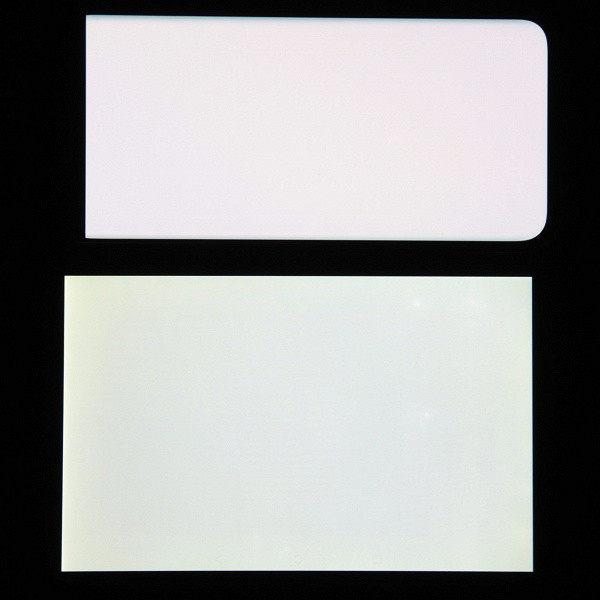
We note good uniformity of brightness and color tone of the white field (with the exception of darkening and changes in hue towards the curved edges).
And a test picture (profile Normal [colors]):

Color reproduction on both screens is good, colors are saturated, although they differ slightly in color balance. However, photographs are not a reliable source for assessing color quality due to differences in the spectral sensitivity of the camera and human vision. For example, the reddish tint in smartphone photos is not as pronounced when viewed directly, which is confirmed by tests using a spectrophotometer.
In photographs, the smartphone screen occupies the entire available image display area and overlaps the curved edges, which leads to color distortion and slight darkening of the edges. These areas are also prone to glare, making it difficult to view images full screen. Even images with an aspect ratio of 16:9 extend off the screen due to its curvature, which can be awkward when watching videos. Such effects are observed even on the short sides of the screen, which increases glare.
The photo was taken with the «Normal Colors» profile active in the screen settings, of the two available.
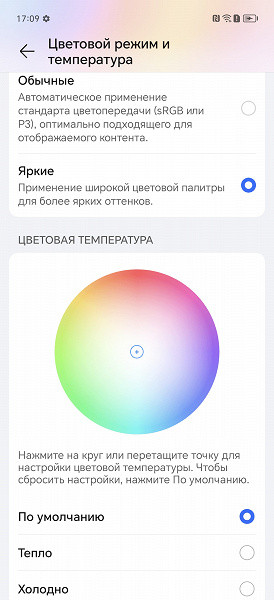
The Vivid [colors] profile features color balance and slightly increased color saturation:

Switching matrix elements occurs almost instantly, however, during the process of turning on the screen, a step with a width of approximately 17 ms (which corresponds to a screen refresh rate of about 60 Hz) or approximately 8 ms (120 Hz) can be observed. For example, this is what it looks like as a function of brightness versus time when moving from black to white:
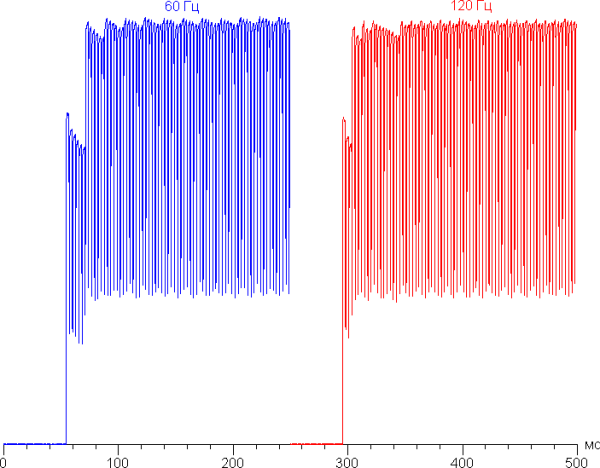
In some situations, the presence of such a step can cause the effect of trails that trail behind moving objects.
Analysis based on 32 points with the same range of gray values showed that the gamma curve does not have a significant deterioration in either the highlights or shadows. The coefficient determined by the power function approximation is 2.15, which is slightly lower than the standard value of 2.2. In this case, the real gamma curve shows a slight deviation from the power-law dependence.

Let us recall that OLED screens are characterized by a dynamic change in the brightness of image fragments depending on its content — it decreases slightly for areas with bright colors. Therefore, the brightness versus hue curve (gamma curve) most likely does not coincide with the gamma curve of a static image, since the measurements were made with consistent grayscale output across almost the entire screen.
The color gamut in the Vivid mode is slightly superior to sRGB, and in the Normal mode it is very close to it.
The color components are mixed with each other, which narrows the color gamut, but in the case of the Normal profile there is more mixing:
Please note that when using wide-gamut screens (without appropriate correction), regular images optimized for sRGB devices may appear unnaturally saturated. Therefore, it is recommended in most cases to select the Normal profile when viewing movies, photos and other natural images.
Honor Magic6 Pro provides the ability to correct color balance by selecting a color temperature profile or adjusting the hue on the color wheel. However, even without correction, the balance of shades when using the Normal profile remains good, since the color temperature is close to the standard 6500 K, and the deviation from the blackbody spectrum (ΔE) remains below 10 units, which is an acceptable indicator for a consumer device. In addition, color temperature and ΔE practically do not change from hue to hue, which has a beneficial effect on the visual assessment of color balance.
Of course, there is a function to reduce the intensity of the blue component:

The description of Eye Protection mode contains incorrect information regarding eye fatigue. Although bright light can disrupt the circadian rhythm, this can be eliminated by reducing the brightness to a comfortable level without distorting the color balance by reducing the contribution of blue light.
There is a Natural Tone function, which should automatically adjust the color balance to environmental conditions. However, when you enable this feature, it does not produce the expected result. However, it should be noted that the inoperability of this function is not a critical drawback, especially for those who do not use this function. This issue may be fixed in future firmware updates.
The smartphone also supports DisplayPort Alt Mode for USB Type-C, which allows you to output image and sound to external devices when connected to a USB port. When connected to a monitor, the video resolution is 1080p at 60 Hz frame rate. There are two operating modes: displaying an alternative desktop (Desktop Mode) or copying the smartphone screen (Phone).
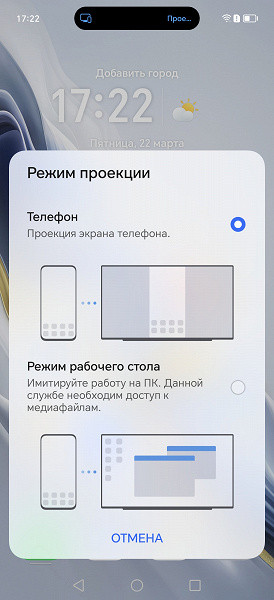
In the second case, when the smartphone screen is in portrait orientation, the image on the TV screen is displayed inscribed in height with wide black margins on the sides. When the smartphone screen is landscape-oriented, the image is displayed inline with narrow black margins at the top and bottom. Point-to-point image output is missing in both options.
In alternate desktop mode, the monitor displays a completely different screen.
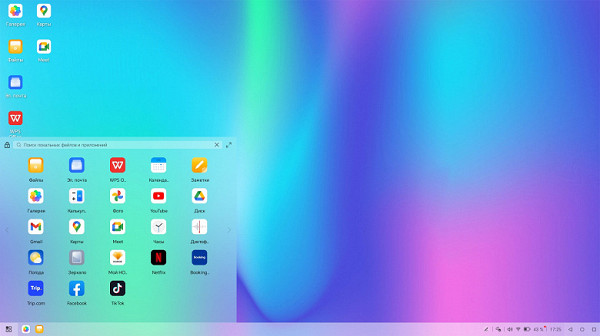
The smartphone screen can serve as a touchpad for coordinate input, a drawing tablet on top of the desktop, or function as a small second desktop.
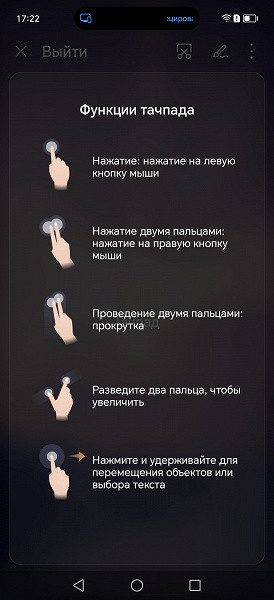
So, the screen of this smartphone is distinguished by high brightness (up to 1200 cd/m²) and excellent anti-glare properties, which allows it to be used outdoors even on a bright sunny day. In conditions of complete darkness, the brightness can be reduced to comfortable values (up to 2 cd/m²). The automatic brightness adjustment mode works reliably. Among the advantages of the screen, it is worth noting its high resolution, effective oleophobic coating, no flicker, support for a high refresh rate (120 Hz), as well as a color gamut close to sRGB and good color balance (if you select the appropriate profile). Not to mention the general advantages of OLED screens, such as true black color and minimal drop in brightness when viewed at an angle. In general, the screen quality is at a high level.
It is also worth noting that the curved edges of the screen can cause color distortion and reduced brightness in the corners of the image, as well as lead to glare in ambient light conditions.
Camera
The Honor Magic6 Pro smartphone is equipped with three full-fledged rear cameras: main, long-focus and wide-angle. All three cameras are equipped with autofocus, and only the wide-angle one does not have an optical stabilizer.
- 50 MP, 1/1.3″, f/1.4—f/2.0, 23 mm, Laser AF, PDAF, OIS (main)
- 180 MP, 1/1.49″, f/2.6, 2.5× optical zoom, PDAF, OIS (long focal length)
- 50 MP, 1/2.88″, f/2.0, 13 mm, 122˚, AF (wide angle)
The main camera has a lens equipped with a variable aperture, which is automatically adjusted based on sensor data, but can also be adjusted manually. By default, the camera uses the pixel binning function, which allows you to take pictures with a resolution of 12.5 megapixels, but the user can manually switch to the full resolution of 50 megapixels (in Hi-Res mode). It should be noted that when the resolution is reduced, it is not a simple merging of pixels in a 4 to 1 ratio, but preliminary cropping with cropping of possibly problematic edges and corners, which generally justifies this approach.
Photos with a resolution of 50 megapixels have higher detail, but this is noticeable mainly in good lighting and in contrasting details. However, such images may have a more noticeable blurry image, and may also exhibit artifacts on plain surfaces (partially removed noise, even at 50 MP), as well as colored spots in the shadows. Exposure, contrast and color balance may also require additional adjustments. Overall, our opinion is that 12.5MP resolution is recommended for shooting on this smartphone.
The image quality on this smartphone is certainly high, although it is not a photography flagship, but rather a flagship smartphone with excellent cameras. Photos are distinguished by high detail, clarity, contrast and volume. There is virtually no noise, artifacts or distortion. The dynamic range is wide, which allows you to successfully shoot scenes without overexposure and loss of detail in both the lightest and darkest areas. Although the color rendition may be a little saturated compared to real-life colors, this can be easily corrected using color filters. Overall, the default picture this camera produces is impressive.
Below are some more examples of pictures taken with the main camera:
The HDR and macro modes perform well. For the latter, the device automatically switches to the wide-angle module.
The camera also excels at portraits: the object clearly stands out against a well-blurred background, maximum detail, wide dynamic range, no blur.
By the way, about motion control. This device features a special motion capture mode that is rarely seen in other devices (here called AI Motion Sensing). In this mode, you don't have to wait or press the shutter button. The camera itself tracks and selects the clearest frame; you just need to point the object and hold the smartphone.

In night mode, the automatic mode also adds color saturation, making photos more spectacular and compensating for the inevitable decrease in detail.
The zoom works as well as the main camera, including 2.5x optical and 5x hybrid. The long-focus lens is equipped with autofocus and a stabilizer, which ensures maximum clarity and blur-free images. The optical zoom also allows you to take pictures in full resolution and with pixel binning.
The wide-angle camera also offers the ability to shoot in pixel binning and full resolution modes, but in the case of 50 MP it is recommended to refrain from shooting. Despite the expected loss of detail, this camera provides consistent color reproduction with the main camera, good geometry (for a wide-angle lens), and contrast and volume in pictures. When shooting in 12.5 megapixel mode, the quality remains very decent.
In the field of video shooting, this smartphone also performs at a high level. It is capable of recording video at a maximum resolution of 4K at frame rates of 60 or 30 fps, providing electronic stabilization based on the built-in gyroscope (gyro-EIS). HDR and log 10-bit video modes are supported. Video shooting is available on all three cameras with smooth switching between them. The image quality is perfect, the stabilization ensures smoothness even when moving, and the excellent sound quality completes the visual experience.
The front camera is also impressive (50 MP, 1/2.93″, f/2.0, 22 mm, AF), offering two options for “focal lengths” thanks to the cropped central part of the image. Like the rear cameras, it provides high detail and is free of highlights and shadow thinning. However, the color rendition may be slightly different, skewed slightly toward a “red” tint.
Telephone and communications
The Honor Magic6 Pro smartphone provides support for mobile networks up to 5G, demonstrating reliable operation in wireless networks in urban environments, including the Moscow region. The connection remains stable and is quickly restored after possible interruptions. The Wi-Fi adapter supports three bands of Wi-Fi 7, and Bluetooth 5.3 and NFC/NFC-SIM are also available. The smartphone also supports e-SIM and has a USB Type-C port with USB 3.2 Gen2 (USB 3.1) mode.
The satellite navigation module works with GPS (L1+L5), Glonass, BDS (B1I+B1c+B2a) and Galileo (E1+E5a). It quickly identifies satellites from a cold start, providing accurate positioning.
The sound quality of the speakers during calls is clear, with maximum volume, and the vibration motor is pleasantly noticeable. The built-in sensors, including the gyroscope, work properly.
Software and multimedia
The Honor Magic6 Pro smartphone runs on the Android operating system with the MagicOS 8 shell. The platform provides full support for Google services and the Google Play Store application store. The interface is optimized for ease of use, providing a smooth and fast experience. Users have access to various settings and personalization options. Multitasking and windowing modes have been implemented, as well as the function of minimizing windows into floating icons for convenient switching between applications.
The top curtain is divided into two parts, making it easier to access different functions depending on where you pull it. In addition to the Google Play Store, the smartphone offers its own application store, as well as the ability to install the Russian RuStore repository for searching and installing Russian applications, including banking ones.
The contactless payment system via the NFC module works smoothly, providing convenient options for secure transactions.
The smartphone is equipped with powerful stereo speakers that reproduce sound with high quality and volume. Both speakers play both their own channel and the opposite channel at a slightly reduced volume, resulting in a more even sound. As a result, the sound quality is high and it is safe to say that this is one of the best mobile speaker systems on the market. The device supports Bluetooth 5.3 and all major profiles for wireless headphones, including aptX, aptX HD and LDAC. However, it's worth noting that the lack of audio output for wired headphones may be a slight drawback for users who prefer to use quality wired headphones.
Performance
The Honor Magic6 Pro smartphone is equipped with a Qualcomm Snapdragon 8 Gen3 processor, which consists of 8 cores: 1 Cortex-X4 core clocked at up to 3.3 GHz, 3 Cortex-A720 cores clocked at up to 3.2 GHz, 2 Cortex-A720 cores with a clock speed of up to 3.0 GHz and 2 Cortex-A520 cores with a clock speed of up to 2.3 GHz. The graphics processor is the Adreno 750 GPU. The smartphone is equipped with 12 GB of LPDDR5X RAM and an additional 8 GB of virtual memory (RAM Turbo). The built-in storage capacity is 512 GB (UFS 4.0). Unfortunately, the smartphone does not have a slot for microSD memory cards. It is possible to connect external devices via the USB Type-C port in USB OTG mode.
The platform is made using a 4 nm process technology, which ensures high performance. In AnTuTu, the smartphone scores more than 1.2 million points in standard mode and more than 1.5 million points in performance mode. The graphics adapter supports the Vulkan API and provides high graphics performance.
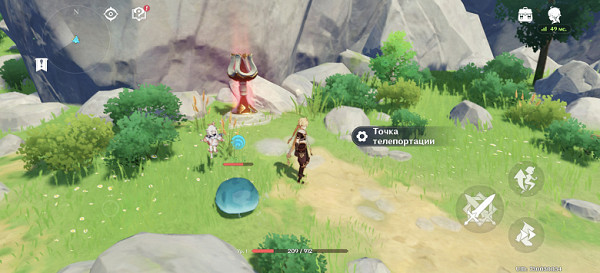
In real-world conditions, the Honor Magic6 Pro smartphone demonstrates high performance, providing a smooth interface and flawless playback of even the most demanding virtual entertainment. All games launch and run without lag, including even the most resource-intensive ones, such as Genshin Impact, at maximum graphics settings.
Testing in comprehensive tests AnTuTu and GeekBench:
To make it easier to analyze the smartphone testing results, we have compiled a table that includes several other devices from different market segments. All devices were tested on the latest versions of popular benchmarks. Considering the limitations on the number of models in one comparison, some worthy and current devices may remain outside of this table, since they were tested on earlier versions of the programs.
| Honor Magic6 Pro (Qualcomm Snapdragon 8 Gen3) | Google Pixel 8 (Google Tensor G3) | Realme 12 Pro+ (Qualcomm Snapdragon 7s Gen2) | Samsung Galaxy S24 Ultra (Qualcomm Snapdragon 8 Gen3) | OnePlus Nord 3 5G (Mediatek Dimensity 9000) | |
|---|---|---|---|---|---|
| AnTuTu (v9.x) (bigger is better) | 1205856 / 1544217* | 714464 | 576685 | 814525 | 789188 |
| GeekBench 6 (bigger is better) | 2139/6582 | 1616/4261 | 894/2801 | 2267/7091 | 1077/3175 |
* in performance mode
Testing the graphics subsystem in 3DMark and GFXBenchmark gaming tests:
| Honor Magic6 Pro (Qualcomm Snapdragon 8 Gen3) | Google Pixel 8 (Google Tensor G3) | Realme 12 Pro+ (Qualcomm Snapdragon 7s Gen 2) | Samsung Galaxy S24 Ultra (Qualcomm Snapdragon 8 Gen3) | OnePlus Nord 3 5G (Mediatek Dimensity 9000) | |
|---|---|---|---|---|---|
| GFXBenchmark Aztec Ruins OpenGL (1080p Offscreen, fps) | 195 | 101 | 35 | 188 | 96 |
| GFXBenchmark Aztec Ruins Vulkan (1080p Offscreen, fps) | 225 | 104 | 39 | 193 | 105 |
| GFXBenchmark Car Chase ES 3.1 (1080p Offscreen, fps) | 161 | 75 | thirty | 120 | 79 |
| GFXBenchmark Manhattan ES 3.1 (1080p Offscreen, fps) | 189 | 136 | 54 | 204 | 151 |
| GFXBenchmark T-Rex (1080p Offscreen, fps) | 267 | 317 | 122 | 324 | 293 |
| 3DMark Wild Life Extreme Vulkan (bigger is better) | 5171 | 2453 | 2302 | ||
| 3DMark Solar Bay (bigger is better) | 8661 |
Testing in browser cross-platform tests:
| Honor Magic6 Pro (Qualcomm Snapdragon 8 Gen3) | Google Pixel 8 (Google Tensor G3) | Realme 12 Pro+ (Qualcomm Snapdragon 7s Gen 2) | Samsung Galaxy S24 Ultra (Qualcomm Snapdragon 8 Gen3) | OnePlus Nord 3 5G (Mediatek Dimensity 9000) | |
|---|---|---|---|---|---|
| Google Octane 2 (bigger is better) | 21955 | 7905 | 30529 | 70812 | 29390 |
| JetStream (bigger is better) | 105 | 44 | 85 | 180 | 76 |
Memory speed test results:
Heat
We test for performance degradation when heated using the Burnout Benchmark program, which allows you to load the CPU, GPU and NPU:
| Stress on | Heating performance as a percentage of maximum |
|---|---|
| CPU | 21% |
| GPU | 53% |
| NPU | 18% |
Battery life
The Honor Magic6 Pro smartphone is equipped with a unique 5600 mAh battery, which results in a surprisingly high level of autonomy. Even in the most demanding usage scenarios, such as a long game of Genshin Impact, the device can last about 9 hours without recharging. For less demanding games, this period can increase to 10 hours.
Testing was carried out under normal load without activating the power saving features, although they are also available on the device. Test conditions included a minimum brightness level (approximately 100 cd/m²). Tests performed included continuous reading in the Moon+ Reader app (with the standard light theme), continuous HD video playback (720p) over a home Wi-Fi network, and Injustice 2 with automatic graphics settings.
| Battery capacity | Reading mode | Video mode | 3D Game Mode | |
|---|---|---|---|---|
| Honor Magic6 Pro | 5600 mAh | 38 h. 00 m. | 30 h. 00 m. | 9:00 a.m. |
| Google Pixel 8 Pro | 5050 mAh | 22:00 | 18:00 | 7:00 am |
| Honor 90 | 5000 mAh | 21:00 | 18:00 | 7:00 am |
| Honor Magic V2 | 5000 mAh | 21:00 | 17:00 | 6:00 am |
| Oppo Find N3 | 4805 mAh | 23:00 | 18:00 | 6:00 am |
| Huawei Mate X3 | 4800 mAh | 14:00 | 10:00 am | 5:00 a.m. |
| Oppo Find N2 | 4520 mAh | 20:00 | 17:00 | 5:00 a.m. |
| Oppo Find N2 Flip | 5000 mAh | 20:30 | 19:00 | 8:00 am |
All figures mentioned represent the maximum possible results achieved under optimal conditions, including no SIM cards installed. Any changes to the use case will likely cause these results to deteriorate.
The Honor Magic6 Pro smartphone is fully charged from the included charger in just 55 minutes. It also supports 66W wireless charging, as well as reverse wireless charging for other devices. Using a wireless charger with a maximum output power of 80 W, the smartphone was fully charged in 3 hours and 20 minutes. It's worth noting that this charger is not made by Honor and therefore may not support its proprietary technologies, if any, and is supposed to support the claimed 66W.
Bottom line
The Honor Magic6 Pro smartphone is a true flagship in all respects, from a powerful processor to long battery life. In general, the device has no serious drawbacks. Compared to other outstanding features, the slight delay in charging speed seems insignificant.

